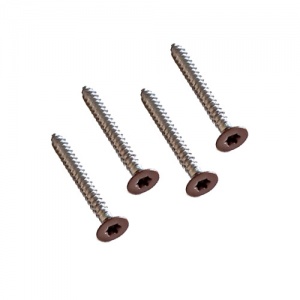Important information about decking & cladding
1. Tannin staining happens in all external wood products.
2. Tannins in WPC (Wood Plastic Composite) decking are a natural component of the wood fibres used in the composite material. They can cause temporary discolouration or staining, particularly in the initial weathering period, as they leach out with rain and UV exposure. These stains are generally temporary and will fade as the decking is exposed to the elements and undergoes normal weathering.
3. Stains - water stain marks can show on composite deck boards. There are 2 main types of water stains; both of which will generally disappear with exposure to general weathering.
3a. Water stains from wood tannins will occur in the early life of your deck as the natural tannins come out of the wood fibres at the surface of the composite decking. This will happen in the early weeks of your deck being laid, and will depend on how exposed to the elements your deck is before the weathering process is complete. This type of stain can be more prominent when new decking is exposed to direct sunlight in the first few months of its life.
3b. Water stains from water pooling or dripping can happen on composite decking just like it can with many other materials/surfaces such as timber decking, glass, laminated flooring etc. This can leave a “shoreline” effect. The visibility of the stain will be governed by factors such as how dirty the decking is and how quickly the water dries from the water pooling again, this can be exaggerated in hotter weather. Both types of marks/stains will disappear naturally over time unless, of course, you have a recurring problem that allows water to continually land on the composite decking. E.g. a drip from the gutter will continue to make marks. Oil or cigarette stains etc. can be very difficult to remove from the surface, avoid contact at all times.
Understanding UV reaction in WPC Composite Wall Cladding
WPC (Wood Plastic Composite) wall cladding is a durable and low-maintenance material ideal for outdoor applications. However, like all exterior products, WPC cladding is exposed to natural weathering over time — including sunlight and its ultraviolet (UV) rays.
What happens when WPC Cladding is exposed to UV light?
When first installed, WPC cladding may exhibit colour changes as it reacts to UV exposure. This is a normal and expected process known as “weathering.” During the initial weeks or months after installation, you may notice:
- Fading or lightening of colour: The surface pigments naturally settle into a more stable shade.
- Increased surface matte effect: The initial glossiness may reduce slightly, resulting in a more natural-looking finish.
This process is most noticeable during the first 8–12 weeks, after which the material stabilises. The degree of change depends on factors such as the colour of the cladding, intensity of sunlight, and geographic location.
Why this happens?
WPC is made from a blend of wood fibers and recycled plastic, and while it’s engineered to resist fading better than traditional timber, UV rays will still affect the surface pigments over time.
Rest Assured: Performance is Unaffected.
It’s important to note that this colour evolution does not impact the structural integrity, performance, or durability of the product. WPC cladding remains weather-resistant, insect-proof, and low-maintenance throughout its lifespan.







